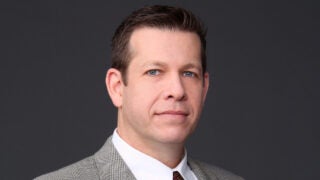Cooling breakthrough could improve performance of quantum computers
USC researchers discover a method to reduce heating, a problem that challenges the potential of the high-powered devices
Quantum computing remains mysterious and elusive to many, but USC Viterbi School of Engineering researchers might have taken us one step closer to bring the superpowered devices to practical reality.
The Information Sciences Institute at USC Viterbi is home to the USC-Lockheed Martin Quantum Computing Center (QCC), a supercooled, magnetically shielded facility specially built to house the first commercially available quantum optimization processors – devices so advanced that there are currently only two in use outside the Canadian company D-Wave Systems, where they were built: The first one went to USC and Lockheed Martin, the second to NASA and Google.
Quantum computers encode data in quantum bits, or “qubits,” which have the capability of representing the two digits of one and zero at the same time – as opposed to traditional bits, which can encode distinctly either a one or a zero. This property, called superposition, along with the ability of quantum states to “interfere” (cancel or reinforce each other like waves in a pond) and “tunnel” through energy barriers, is what may one day allow quantum processors to ultimately perform optimization calculations much faster than is possible using traditional processors. Optimization problems can take many forms, and quantum processors have been theorized to be useful for a variety of machine learning and big data problems like stock portfolio optimization, image recognition and classification, and detecting anomalies.
Yet, because of the exotic way in which quantum computers process information, they are highly sensitive to errors of different kinds. When such errors occur they can erase any quantum computational advantage — so developing methods to overcome errors is of paramount importance in the quest to demonstrate “quantum supremacy.”
USC researchers Walter Vinci, Tameem Albash and Daniel Lidar put forth a scheme to minimize errors. Their solution, explained in the article “Nested Quantum Annealing Correction” published in the journal Nature Quantum Information, is focused on reducing and correcting errors associated with heating, a type of errors that is common and particularly detrimental in quantum optimizers. Cooling the quantum processor further is not possible since the specialized dilution refrigerator that keeps it cool already operates at its limit, at a temperature approximately 1,000 times colder than outer space.
Vinci, Albash and Lidar have developed a new method to suppress heating errors: By coupling several qubits together on a D-Wave Two quantum optimizer, without changing the hardware of the device, these qubits act effectively as one qubit that experiences a lower temperature. The more qubits are coupled, the lower is the temperature experienced, allowing researchers to minimize the effect of heating as a source of noise or error. This nesting scheme is implementable not only on platforms such as the D-Wave processor on which it was tested, but also on other future quantum optimization devices with different hardware architectures.
The researchers believe that this work is an important step in eliminating a bottleneck for scalable quantum optimization implementations. “Our work is part of a large scale effort by the research community aimed at realizing the potential of quantum information processing, which we all hope might one day surpass its classical counterparts,” said Lidar, a USC Viterbi professor and QCC scientific director.



